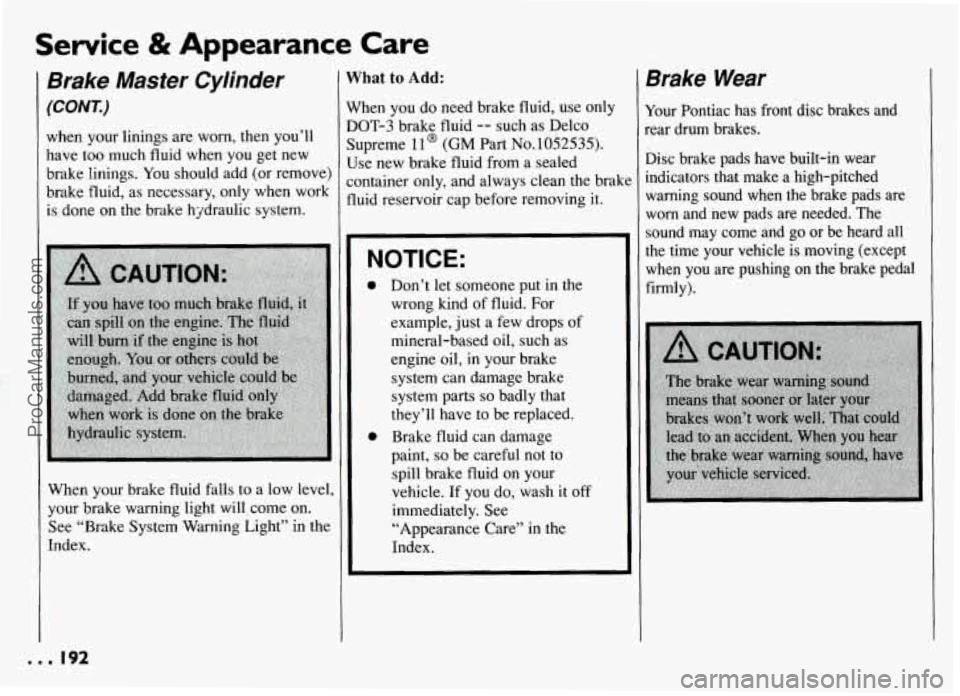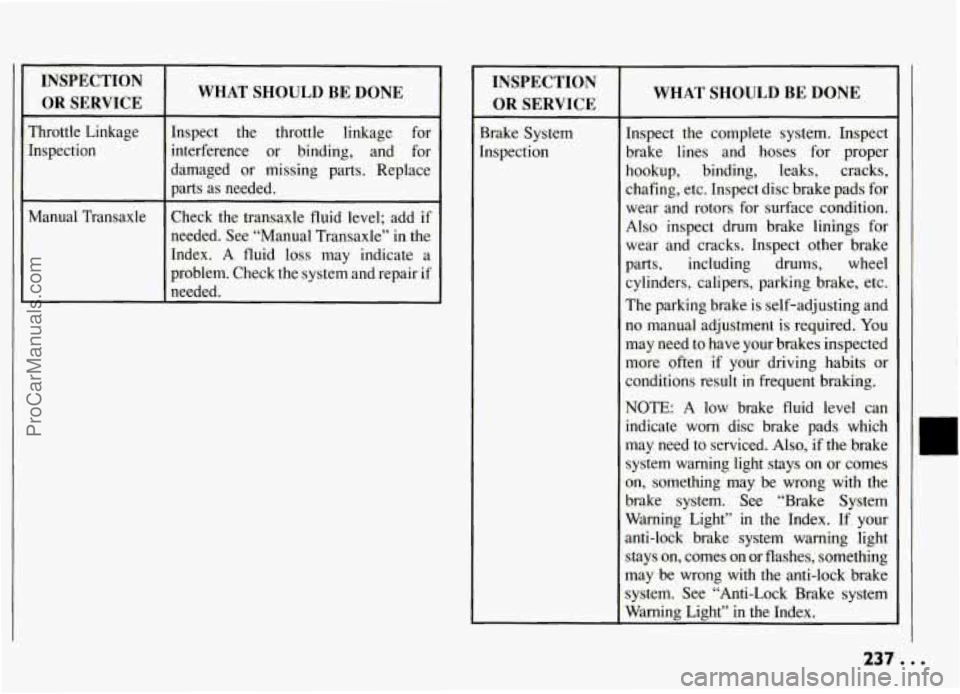Page 193 of 274

Service & Appearance Care
Brake Master Cylinder
(CONT.)
when your linings are worn, then you’ll
have too much fluid when you get new
brake linings. You should add (or remove)
brake fluid, as necessary, only when work
is done on the brake hydraulic system.
When your brake fluid falls to a low level.
your brake warning light wil1,come on.
See “Brake System Warning Light” in the
Index.
What to Add:
When you do need brake fluid, use only
DOT-3 brake fluid -- such as Delco
Supreme
11 @ (GM Part No. 1052535).
Use new brake fluid from a sealed
:ontainer only, and always clean the brak
fluid reservoir cap before removing it.
NOTICE:
e
0
Don’t let someone put in the
wrong kind
of fluid. For
example, just a few drops
of
mineral-based oil, such as
engine oil, in your brake
system can damage brake
system parts
so badly that
they’ll have to be replaced.
Brake fluid can damage
paint,
so be careful not to
spill brake fluid on your
vehicle. If you
do, wash it off
immediately. See
“Appearance Care” in the
Index.
3rake Wear
‘our Pontiac has front disc brakes and
ear drum brakes.
Xsc brake pads have built-in wear
ndicators that make a high-pitched
varning sound when the brake pads are
vorn and new pads are needed. The
ound may come and
go or be heard all
he time your vehicle is moving (except
when you are pushing on the brake pedal
irmly).
ProCarManuals.com
Page 194 of 274

NOTICE:
Continuing to drive with worn-out
brake pads could result
in costly
brake repair.
_r
Some driving conditions or climates may
cause a brake squeal when the brakes are
first applied or lightly applied. This does
not mean something is wrong with your
brakes.
Your rear drum brakes don't have wear
indicators, but
if you ever hear a rear
brake rubbing noise, have the rear brake
linings inspected.
Also, the rear brake
drums should be removed and inspected
each time the tires are removed for
rotation or changing. When you have the
front brakes replaced, have the rear
brakes inspected, too.
Brake linings should always be replaced
as complete axle sets,
Brake Pedal Travel
See your dealer if the brake pedal does
not return to normal height, or if there is a
rapid increase
in pedal travel. This could
be a sign of brake trouble.
Brake Adjustment
Every time you make a moderate brake
stop, your disc brakes adjust for wear. If
you rarely make a moderate or heavier
stop,
then your brakes might not adjust
correctly. If
you drive in that way, then
-- very carefully -- make a few moderate
brake stops about every
1,000 miles
( 1600 km), so your brakes will adjust
properly.
If your brake pedal goes down farther
than normal, your rear drum brakes may
need adjustment. Adjust them by backing
up and firmly applying the brakes a few
times.
Replacing Brake System
Parts
The braking system on a modern vehicle
is complex. Its many parts have
to be of
top quality and work
well together if the
vehicle is to have really good braking.
Vehicles we design and test have
top-quality
GM brake parts in them, as
your Pontiac does when
it is new. When
you replace parts of your braking
system
-- for example, when your brake
linings wear down and you have to have
new ones put
in -- be sure you get new
genuine
GM replacement parts. If you
don't, your brakes may no longer 'work
properly. For example, if someon? puts in
brake linings that are wrong for your
vehicle, the balance between your front
and rear brakes can change, for the worse.
The braking performance you've come to
expect can change
in many other ways if
someone puts in the wrong replacement
brake parts.
193...
ProCarManuals.com
Page 238 of 274

INSPECTION
OR SERVICE
Throttle Linkage
Inspection
Manual Transaxle
WHAT SHOULD BE DONE
Inspect the throttle linkage for
interference or binding, and for
damaged or missing parts. Replace
parts as needed.
Check the transaxle fluid level; add if
needed. See “Manual Transaxle” in the
Index.
A fluid loss may indicate a
problem. Check the system and repair if
needed.
INSPECTION
OR SERVICE
Brake System
Inspection
WHAT SHOULD BE DONE
Inspect the complete system. Inspect
brake lines and hoses for proper
hookup, binding, leaks, cracks,
chafing, etc. Inspect disc brake pads for
wear and rotors for surface condition.
Also inspect drum brake linings for
wear and cracks. Inspect other brake
parts, including drums, wheel
cylinders, calipers, parking brake, etc.
The parking brake is self-adjusting and
no manual adjustment is required. You
may need to have your brakes inspected
more often
if your driving habits or
conditions result
in frequent braking.
NOTE: A low brake fluid level can
indicate worn disc brake pads which
may need to serviced. Also, if the brake
system warning light stays
on or comes
on, something may be wrong with the
brake system. See “Brake System
Warning Light”
in the Index. If your
anti-lock brake system warning light
stays
on, comes on or flashes, something
may be wrong with the anti-lock brake
system. See “Anti-Lock Brake system
Warning Light” in
the Index.
237
ProCarManuals.com